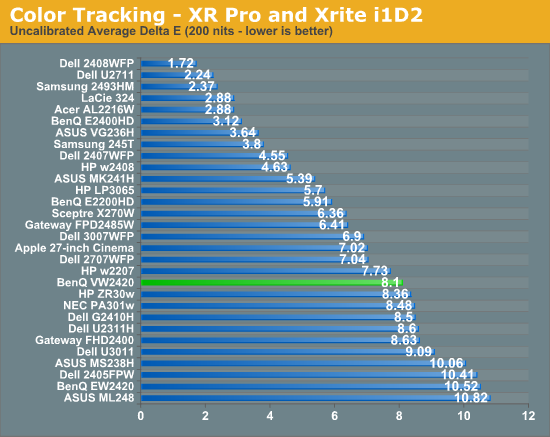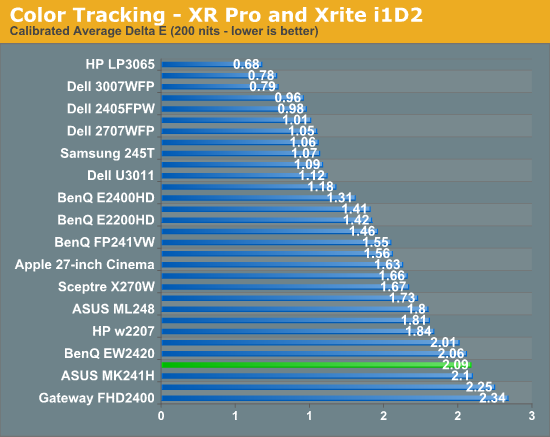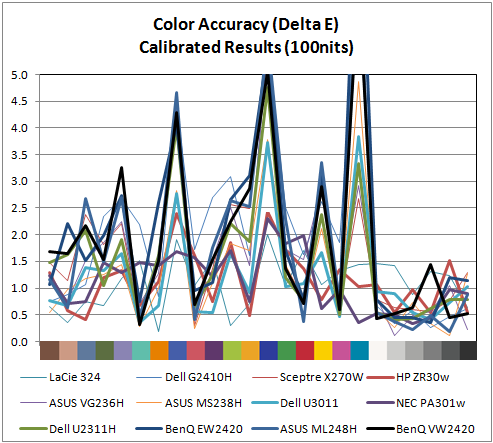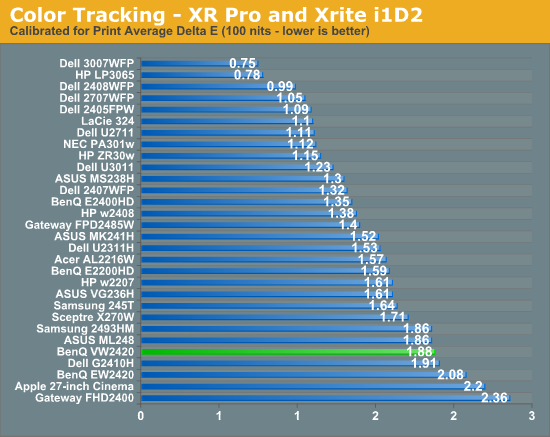BenQ VW2420H Monitor Review
by Chris Heinonen on December 10, 2011 2:45 AM ESTViewing Angles and Color Quality
The BenQ uses a *VA panel (specifically A-MVA) and because of that the viewing angles on it are overall very good. You can get a bit of contrast shifting when you move to the extremes, but for all practical purposes there should be no real contrast shifts while working on it. Since this is designed just for desktop work and not for multiple people to use while gaming or watching TV, the viewing angles are very good.
When initially hooked up and set to 200 nits of light output, the average dE of the BenQ is in the high single digits, which unfortunately is very good for a consumer class LCD monitor—only higher quality professional (or at least prosumer) displays tend to be factory calibrated for accurate colors. The worst color is pure white, with the rest of the grayscale getting better as it gets darker, but overall this isn’t a monitor you would want to use for serious color work straight out of the box.


Of course, the uncalibrated results won’t be that important to people that care about color quality, since they would be calibrating the monitor regardless of the performance out of the box. In this case the BenQ performs well, though it's strictly average for a consumer display. Our average dE comes down to just about 2, and the majority of the grayscale is at 1 or below. The main errors are in the blue swatches that cause most displays issues, or fall outside of the sRGB colorspace. Calibrated the BenQ falls strictly in the “good, not exceptional” category for dE performance.


If you are doing print work and using a light output of closer to 100 nits than 200 nits, the performance of the BenQ is slightly better, but still in the range of most displays. The grayscale is more accurate which I like to see, and the color errors are in the same positions as before. If the 200 nits calibration data was close enough to accurate for you, then the 100 nits calibration data will be good enough as well, but the numbers are very similar.












48 Comments
View All Comments
mike55 - Saturday, December 10, 2011 - link
BenQ's website says this monitor has an 8-bit panel with 24-bit interpolation. I don't understand why interpolation is used for a panel that's capable of displaying 24-bit color. Could someone explain this, please?marraco - Saturday, December 10, 2011 - link
If I need a machine to tell the color accuracy of a monitor, well, then I don’t care much about it. I’m not sensible on color accuracy.But If I read an Anandtech article about a monitor, then I buy the monitor, and text looks blurry when I scroll web pages, PDF, and word documents, then I blame the Anandtech article which said NOT A WORD about things that matter.
snuuggles - Sunday, December 11, 2011 - link
Man, I couldn't agree more. I'm not sure who these reviews are for. There are so few people that really care about color accuracy.- input lag
- 120hz
- ?? what else matters? I'm personally a little hazy on why any gamer would settle for 60hz when 120hz is just *so* much better.
Now that I think about it, my guess is that the market for people who care about quality monitors (ie, people that know anything at all about displays) and who *aren't* photographers/graphic artists must be vanishingly small, which is why the reviews seem to cater to that crowd.
cheinonen - Sunday, December 11, 2011 - link
There are people who care about color accuracy and those who care about input lag, and those who care about both. I can't venture to assume what percentage of people care about which unfortunately, though I care far more about color accuracy than input lag myself as I rarely game but do a lot of image and general work where the colors annoy me. However, I know I don't represent everyone so I try to cover everything I can.The next display up is a 120 Hz display, so there will be comments on that of course. I'm attempting to find a better way to measure the actual motion resolution on displays, but have run into a couple issues on that so far:
- The test patterns max out at 1920x1080
- The output is limited to 60 Hz
So the 120 Hz display can't take full advantage of the panel for that. I'm trying to find a way to measure that better, as motion resolution is something that is hard to really get across right now.
I'm trying to cover all the bases for reviews, and trying to clear out the backlog of monitors that are here so I can start to better select what the comments are interested in.
sulu1977 - Sunday, December 11, 2011 - link
60 Hz monitors give me eyestrain every time. My next monitor absolutely has to be 120 Hz or higher.Zan Lynx - Monday, December 12, 2011 - link
Exactly how does the refresh rate on a LCD cause eye strain for you? I can see that with a CRT it would because the low phosphor persistence on high refresh rate CRTs would cause flicker when used at a lower refresh rate.With an LCD the pixel stays set until the displays gets a refresh. It doesn't flicker. At all.
You might be seeing a 60Hz flicker of the LCD's fluorescent backlight tubes. If that is the problem, then you need to find a monitor manufacturer that uses a better backlight..
It could also be caused by your eyes being badly affected by interference patterns generated by room fluorescent lighting flicker combining with LCD backlight flicker.
In none of these cases will a 120Hz refresh LCD solve your problem except by a new display coincidentally using a different backlight.
sulu1977 - Tuesday, December 13, 2011 - link
I thought my new LED LCD laptop would finally get rid of eyestrain forever, but I was very wrong. Just passing my fingers across the screen reveals obvious flicker. Without getting into deep technical analysis, the bottom line is this:I can stare at a tree in my yard and never get eye strain/fatigue, but staring at my new 60Hz LED LCD gives me eye strain/fatigue every time.Oxford Guy - Tuesday, December 13, 2011 - link
Next-generation panels from the maker of the panels used in these BenQ monitors are being produced and are about to be produced:http://www.tftcentral.co.uk/news_archive/25.htm#au...
Some have a 5000:1 contrast ratio rating (up from 3000:1). Some are 120 Hz. They have a faster response rating of 6 ms g2g rather than 8 ms, and 12 ms overall rather than 25 ms.
The first announced panel that appears to use one of these is the Phillips 241P4QPYEB/27 and 241P4QPYES/00. The only difference between the two is the color of the frame.